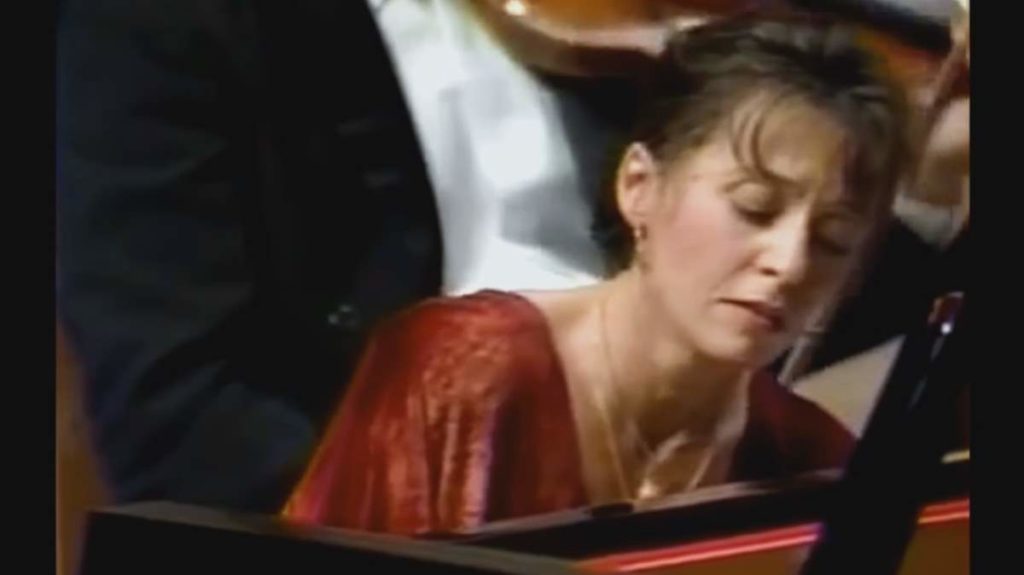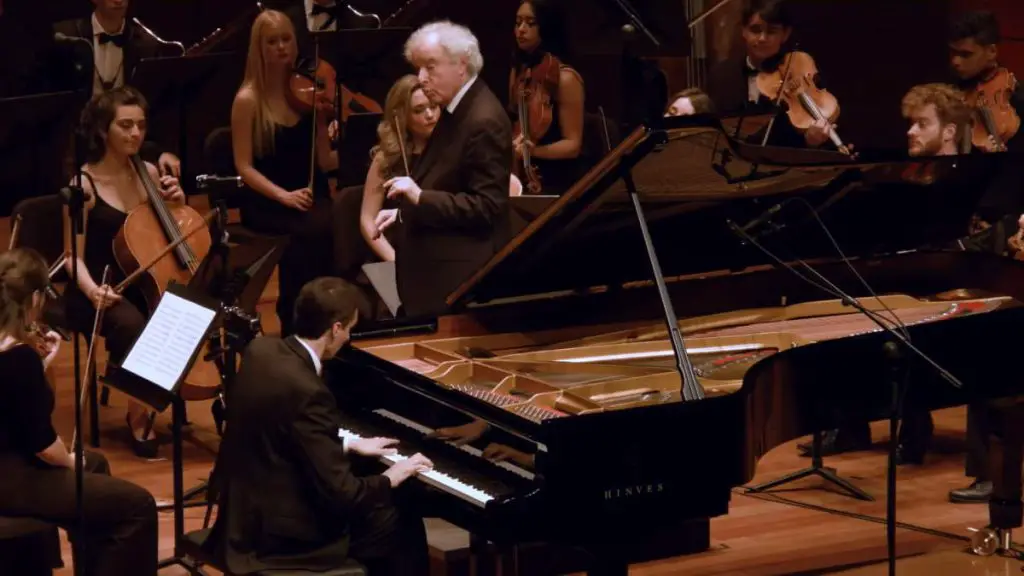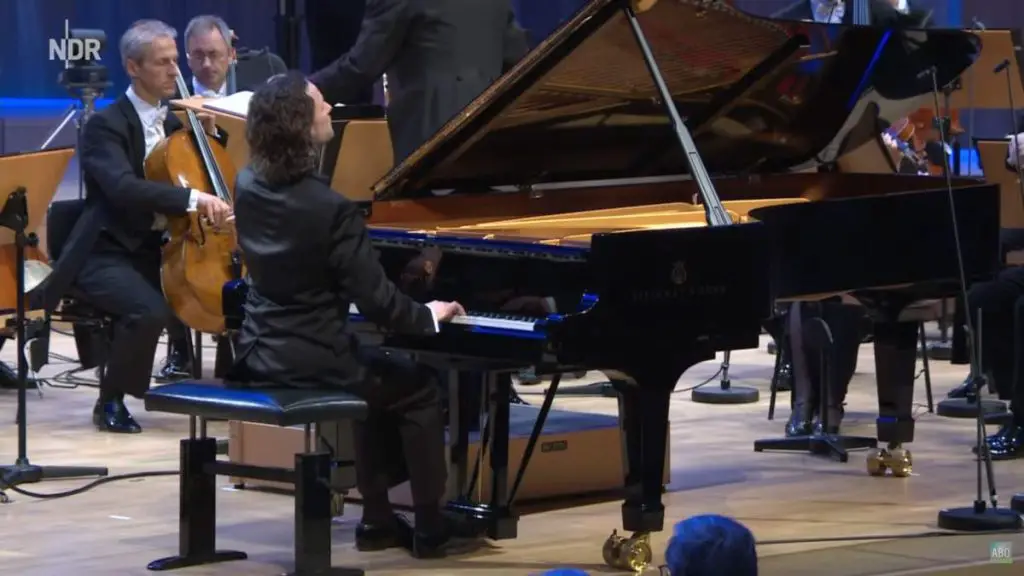Accompanied by the Wiener Philharmoniker, Leonard Bernstein performs Wolfgang Amadeus Mozart’s Piano Concerto No. 17 in G major, KV. 453. Bernstein also conducts the orchestra. This performance was recorded on October 11, 1981, at the Wiener Musikverein.
Wolfgang Amadeus Mozart’s Piano Concerto No. 17
Wolfgang Amadeus Mozart’s Piano Concerto No. 17 in G major, K. 453, is a work of remarkable beauty and sophistication, composed in 1784, during a period of great productivity and creativity for Mozart. This concerto is celebrated for its expressive depth, intricate melodies, and the innovative dialogue between the piano and orchestra. Mozart composed it for his student, Barbara Ployer, demonstrating its intent as a piece both for performance and pedagogy.
One of the most distinctive features of this concerto is the way Mozart integrates the piano part with the orchestral texture, creating a seamless interplay that was somewhat revolutionary for its time. The concerto showcases Mozart’s mastery of form and his ability to imbue classical structures with a wide range of emotions and characters. Its orchestration is notable for the inclusion of woodwinds, which Mozart employs with great effect to color and shade the musical dialogue.
The concerto is also remarkable for its thematic development and the use of motifs, which Mozart manipulates with exceptional skill. He weaves these motifs throughout the concerto, creating a cohesive musical narrative that is both engaging and profound. The work reflects Mozart’s deep understanding of the piano concerto as a genre and his ability to push its boundaries, exploring new possibilities in musical expression and form.
Movements
With the start times in the video above:
- 00:39 Allegro
- 13:26 Andante
- 26:06 Allegretto – Presto
1. Allegro
The first movement of Mozart’s Piano Concerto No. 17 in G major, K. 453, is marked “Allegro,” setting the stage with a lively and joyful opening that immediately captures the listener’s attention. Characterized by its elegance and clarity, this movement is a fine example of Mozart’s mastery in blending the solo piano with the orchestra in a concerto setting.
The movement follows the classical sonata-allegro form, which includes an exposition, development, and recapitulation, allowing Mozart to explore thematic material in a dynamic and structured manner. The exposition introduces the main themes, which are notable for their lyrical beauty and melodic inventiveness. The piano and orchestra engage in a sophisticated dialogue, exchanging themes and motifs in a manner that highlights the soloist’s virtuosity and the ensemble’s responsiveness.
During the development section, Mozart demonstrates his compositional brilliance by manipulating and varying the thematic material, creating tension and anticipation. This section explores a wider range of harmonies and textures, showcasing the composer’s ability to create complex musical conversations between the piano and orchestra.
The recapitulation brings back the main themes, now enriched and transformed by their journey through the development. Mozart ensures a cohesive unity throughout the movement, while also allowing for moments of spontaneity and improvisation, which were typical of concertos performed during his time.
The movement concludes with a cadenza, traditionally an opportunity for the soloist to showcase their technical skill and musicality in a more free-form manner. Mozart’s own cadenzas for this concerto, when used, add a personal touch that integrates seamlessly with the rest of the movement, leading to a satisfying and harmonious conclusion.
2. Andante
The second movement of Mozart’s Piano Concerto No. 17 in G major, K. 453, is marked “Andante,” and it unfolds as a serene and expressive contrast to the vivacious first movement. This movement is a showcase of Mozart’s ability to create profound emotional depth through simplicity and elegance in melody.
Set in a tranquil and introspective mood, the Andante is characterized by its lyrical beauty and the delicate interplay between the piano and the orchestra. The movement features a theme and variations structure, a form that Mozart frequently employed to great effect. This approach allows him to explore a wide range of emotions and colors within a single thematic framework, demonstrating his mastery of variation technique.
The main theme is introduced by the orchestra and is notable for its graceful and singing quality. When the piano enters, it takes up this theme, embellishing and expanding upon it with exquisite ornamentation and sensitivity. Each variation explores different aspects of the theme, with changes in dynamics, articulation, and harmony that breathe new life into the melodic material.
The interaction between the solo piano and the orchestra is particularly poignant in this movement, with the orchestra providing a lush and supportive backdrop to the piano’s explorations. The variations progress, each adding a layer of complexity and emotional nuance, leading to moments of great beauty and introspection.
Mozart’s use of the theme and variations form in the Andante is a testament to his compositional skill and his ability to communicate deep feelings through music. The movement is a delicate balance of simplicity and sophistication, offering a moment of calm reflection amidst the more extroverted movements of the concerto.
3. Allegretto – Presto
The third movement of Mozart’s Piano Concerto No. 17 in G major, K. 453, is marked “Allegretto,” offering a delightful and spirited finale to the concerto. This movement is distinguished by its playful character and the masterful interplay between the solo piano and the orchestra. It showcases Mozart’s ability to craft music that is both engaging and sophisticated, blending light-heartedness with intricate musical ideas.
Structured as a theme with variations, the movement explores a simple, yet charming melody introduced at the beginning. This theme serves as a canvas for Mozart’s creativity, as he subjects it to a series of variations that explore different moods, textures, and harmonic landscapes. Each variation highlights a different aspect of the piano’s capabilities, from lyrical passages and virtuosic flourishes to delicate interludes and robust, orchestral textures. The variations are not only a display of the soloist’s technical prowess but also a testament to Mozart’s genius in variation form, demonstrating his ability to transform a single theme into a multitude of expressive forms.
The orchestration in this movement is particularly effective in complementing and contrasting the piano’s role. The woodwinds, strings, and brass each play significant roles in the variations, sometimes supporting the piano and at other times engaging in a lively dialogue with it. This interaction enriches the texture and adds depth to the musical conversation.
One of the most charming aspects of this movement is its sense of spontaneity and joy. Despite the complexity of the variations and the sophistication of the orchestration, there is an overarching feeling of playfulness and ease that pervades the movement. This characteristic makes the finale both accessible and deeply satisfying, encapsulating the essence of Mozart’s musical genius.
The third movement concludes the concerto on a high note, leaving the audience with a sense of fulfillment and admiration for Mozart’s compositional skill. It is a fitting end to a work that is celebrated for its beauty, inventiveness, and emotional depth, showcasing the enduring appeal of Mozart’s music.
Sources
- Piano Concerto No. 17 (Mozart) on Wikipedia
- Mozart: Piano Concerto No. 17 on the LA Phil website
- Wolfgang Amadeus Mozart’s Piano Concerto No. 17 in G, K.453 on the Boston Symphony Orchestra website
- Piano Concerto No.17 in G major, K.453 (Mozart, Wolfgang Amadeus) on the International Music Score Library Project website


